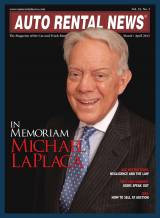Magazine for the professional car and truck rental industry.
Page 19 of 35
SHARING A
s they expand from urban areas and college campuses, car-sharing services such as Zipcar, Hertz On Demand
and Enterprise's WeCar are evolving to form partnerships with city governments and the corporate world. But is car sharing for everyone? T ese six car sharers, from professionals to university students, reveal their experienc- es on how they coordinate car sharing with other forms of transportation and deal with issues such as parking, availability and time management. T rough it all, their views on car ownership have changed.
Reasons for Joining
Lisa King lives in Washington, D.C. and has been a Zipcar member for six years. Her car was 10 years old when she decided to join, and it needed extensive work. At the time, King had a job change and realized she didn't need her car for work anymore since she was no longer going to be in sales. Meanwhile, Zipcar put in two vehicles at the Metro station next to her apartment. T en, her building began to charge for parking. "So I thought, 'I could ditch my car completely,'" King says. And she did, and hasn't owned a vehicle since. "Now, I spend less on driving than I did on insurance alone, let alone maintenance and gas," says King, who reserves a car one to two times a week. She mostly uses the service to go up to a local farm, or on days she's at her offi ce late or has something large to carry. Otherwise, King uses the city's rail system to get to work. "If I didn't live near public trans- portation or Zipcar, I guess I would have to buy another car," she says. "But I really pre- fer being able to grab a car for what I need." Adam Rodriguez, a sophomore at Duke
18 ARN • MARCH / APRIL 2012
THE EXPERIENCE
Six car-sharing users reveal their reasons for joining a car- share service, how they use them and how they deal with issues such as parking, availability and time management. BY JOANNE M. TUCKER
University and on-campus resident, is hap- py to have WeCar available since he's nev- er owned a car. Rodriguez tends to consoli- date his trips, and uses WeCar at least once a month for about two to three hours. In his fi rst year on campus, Rodriguez of- ten bummed rides from friends. "I liked the idea of being able to get stuff done on my own time," he says. Ironically, Rodriguez now gives rides to friends who also don't have a vehi- cle on campus.
Nichole Kimbell, a California State Univer- sity, Long Beach (CSULB) student who also lives in on-campus housing, uses the Zipcar service a couple times a week to go grocery shopping or pick up friends from the airport. Previously, she was helping her sister pay for a new car, even though she rarely used it. "T at was costly on my part," she says. "But with a Zipcar, I am able to pay for how many hours that I actually need to drive."
When Karen Hammerle moved to Hobo-
ken, N.J., she tried to keep her car, but "it was a disaster," she says. "It was impossible to fi nd parking and I was getting ticketed, and then with the snow it was diffi cult, so I gave up on the car pretty quickly," Hammerle says. She came across Hertz On Demand, which she now uses to supplement her public tran- sit commute into New York City every day. Hammerle says she primarily uses the ser- vice when she has a lot of groceries or when she's going to visit her sister. Instead of taking three or four trains for a three-hour journey to visit her sister, she reserves a Hertz On De- mand vehicle to tackle what's only a 40-min- ute drive. "If I'm going where the public trans- portation is just inconvenient, that's when I will grab a car," she says.
PHOTO BY VICTORIA SANCHEZ
In 2009, California State University, Long Beach offi cials welcomed the launch of Zipcar on campus, which now includes six vehicles. From left to right: Chris Chavez, student government president from 2009-2010; Mary Stephens, VP, administration and fi nance; Elissa Thomas, alternate transportation coordinator; and Doug Robinson, VP, student services.
Without car sharing, Hammerle says it would be diffi cult to use public transporta- tion, just as it would be diffi cult for her to use car sharing without public transportation. "I never thought I was going to give up my car, but the frustration made it so easy for me, es- pecially when I knew there was another op- tion," she says.
Another Zipcar user, Seattle-resident Damien DeOnier, uses the service for a sec- ondary vehicle while his wife takes their car to work every day. DeOnier works from home half the week and takes public transportation when going into the offi ce. DeOnier's month- ly Zipcar cost is usually $100 to $125. "I was kind of nervous about losing my freedom of not having a vehicle," he says. But aſt er using Zipcar for two years, that worry is nonexistent. "It helps me lead a more fl ex- ible lifestyle, where I don't have to deal with maintenance, insurance, extra car payments or parking."
One of DeOnier's favorite aspects to Zip- car membership is the ability to use it when traveling, such as during a recent trip to Eu- rope and a business trip to Washington, D.C. In Philadelphia, John Grummere began us- ing PhillyCarShare a short while aſt er selling
